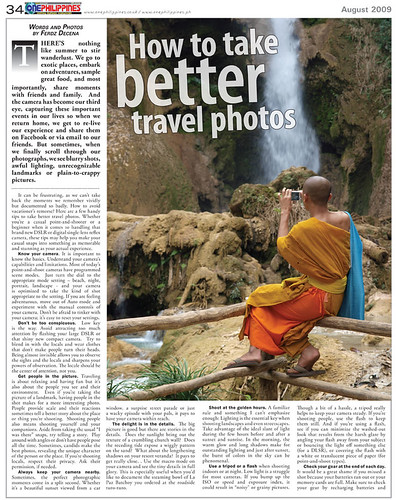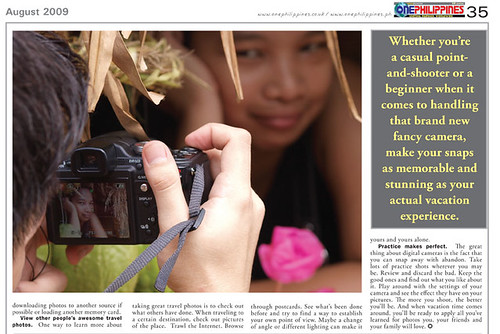
People have been asking for tips on how to get the most when taking photos during their travels. I’m sharing here and article I wrote for One Philippines, an entertainment and lifestyle newsmagazine for the millions of Overseas Filipino Workers and Pinoy migrants. It’s a general set of pointers both for point-and-shooters and new to DSLR cameras:
There’s nothing like summer to stir wanderlust. We go to exotic places, embark on adventures, sample great food, and most importantly, share moments with friends and family. And the camera has become our third eye, capturing these important events in our lives so when we return home, we get to re-live our experience and share them on Facebook or via email to our friends. But sometimes, when we finally scroll through our photographs, we see blurry shots, awful lighting, unrecognizable landmarks or plain-to-crappy pictures.
It can be frustrating, as we can’t take back the moments we remember vividly but documented so badly. How to avoid vacationer’s remorse? Here are a few handy tips to take better travel photos. Whether you’re a casual point-and-shooter or a beginner when it comes to handling that brand new DSLR or digital single-lens reflex camera, these tips may help you make your casual snaps into something as memorable and stunning as your actual experience.
Know your camera. It is important to know the basics. Understand your camera’s capabilities and limitations. Most of today’s point-and-shoot cameras have programmed scene modes. Just turn the dial to the appropriate mode setting – beach, night, portrait, landscape – and your camera is optimized to take the kind of shot appropriate to the setting. If you are feeling adventurous, move out of Auto mode and experiment with the manual controls of your camera. Don’t be afraid to tinker with your camera; it’s easy to reset your settings.
Don’t be too conspicuous. Low key is the way. Avoid attracting too much attention by flashing your large DSLR or that shiny new compact camera. Try to blend in with the locals and wear clothes that don’t make people turn their heads. Being almost invisible allows you to observe the sights and the locals and sharpens your powers of observation. The locale should be the center of attention, not you.

Get people in the picture. Traveling is about relaxing and having fun but it’s also about the people you see and their environment. Even if you’re taking the picture of a landmark, having people in the shot makes for a more interesting photo. People provide scale and their reactions sometimes tell a better story about the place or thing you’re shooting. Shooting people also means shooting yourself and your companions. Aside from taking the usual “I was there” snaps, try telling a story. Play around with angles or don’t have people pose all the time. Sometimes, candids make the best photos, revealing the unique character of the person or the place. If you’re shooting locals, respect their privacy. Ask their permission, if needed.
Always keep your camera nearby. Sometimes, the perfect photographic moments come in a split second. Whether it’s a beautiful sunset viewed from a car window, a surprise street parade or just a wacky episode with your pals, it pays to have your camera within reach.
The delight is in the details. The big picture is good but there are stories in the details. Does the sunlight bring out the texture of a crumbling church wall? Does the receding tide expose a wiggly pattern on the sand? What about the lengthening shadows on your resort veranda? It pays to get really close. Use the macro mode on your camera and see the tiny details in full glory. This is especially useful when you’d like to document the steaming bowl of La Paz Batchoy you ordered at the roadside turo-turo.
Shoot at the golden hours. A familiar rule and something I can’t emphasize enough: Lighting is the essential key when shooting landscapes and even streetscapes. Take advantage of the ideal slant of light during the few hours before and after a sunset and sunrise. In the morning, the warm glow and long shadows make for outstanding lighting and just after sunset, the burst of colors in the sky can be phenomenal.
Check your gear at the end of each day. It would be a great shame if you missed a shot because your batteries ran out or your memory cards are full. Make sure to check your gear by recharging batteries and downloading photos to another source if possible or loading another memory card.
View other people’s awesome travel photos. One way to learn more about taking great travel photos is to check out what others have done. When traveling to a certain destination, check out pictures of the place. Trawl the Internet. Browse through postcards. See what’s been done before and try to find a way to establish your own point of view. Maybe a change of angle or different lighting can make it yours and yours alone.
Practice makes perfect. The great thing about digital cameras is the fact that you can snap away with abandon. Take lots of practice shots wherever you may be. Review and discard the bad. Keep the good ones and find out what you like about it. Play around with the settings of your camera and see the effect they have on your pictures. The more you shoot, the better you’ll be. And when vacation time comes around, you’ll be ready to apply all you’ve learned for photos you, your friends and your family will love.
Text and Photos by Ferdz Decena
Published by OnePhilippines, edited by Ces Rodriguez


Leave a Reply